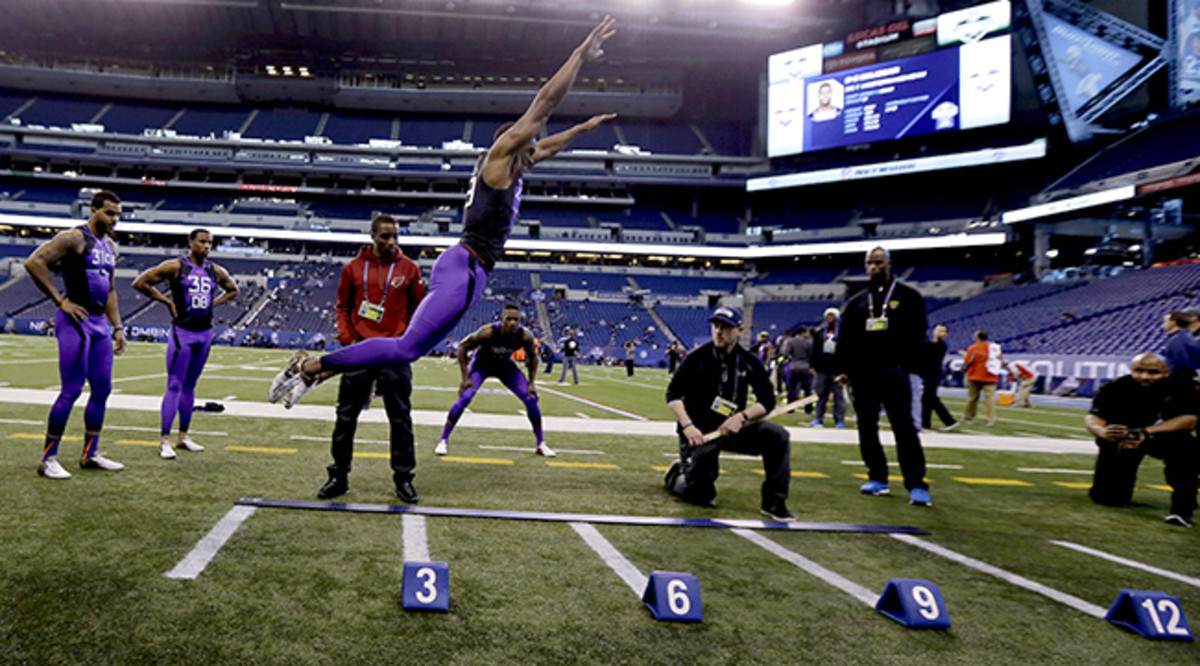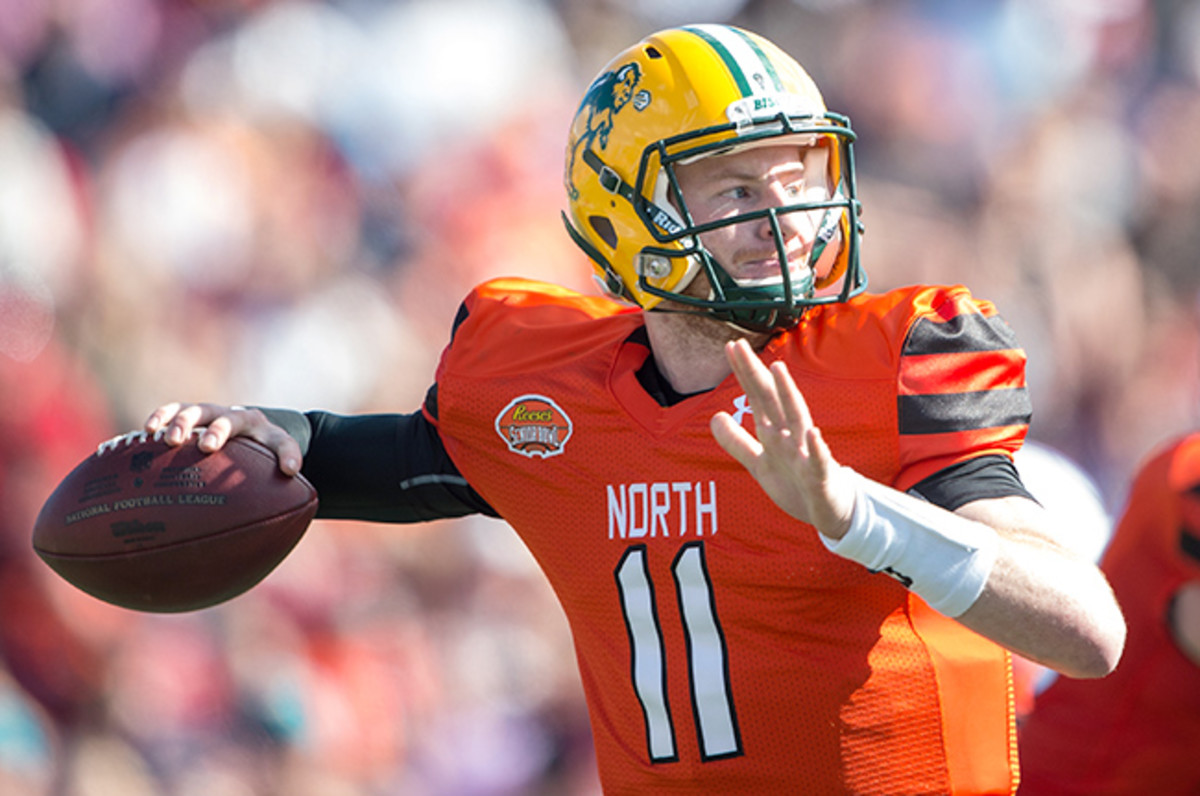The NFL Combine and You

1. Who are these new head coaches and GMs?
The press conferences that (nearly) all the league’s general managers and head coaches are compelled to give in Indianapolis can somehow be both utterly fascinating and mindlessly boring—sometimes both at the same time. For the most recent hires, the combine podium is one of the first times they will speak publicly about their new teams since introductory press conferences (which rarely dig into details about offseason plans). On Wednesday, Adam Gase, Doug Pederson, Dirk Koetter and Ben McAdoo will all field questions from reporters—both onstage and off—in a setting they never have experienced before.
But even for coaches who have never had the top job, there’s not much anonymity at this point. (We’ve worried about Ben McAdoo’s barber choices for a while now.) With general managers, that familiarity doesn’t exist. When I went to the combine in 2014, Dave Gettleman was a 63-year-old second-year GM in Carolina. I wouldn’t have been able to pick him out of a lineup. But when the questions started, he was an engaging, (relatively) honest presence who was still in the throes of learning how to build a team. Arizona’s Steve Keim was also in year two, and he gave some insights on everything from his strategy for pursuing free agents to why he felt compelled to ride with Carson Palmer rather than reach for a quarterback with the 20th pick. In a day full of non-answers and monotonous repetition, there were still nuggets worth hearing from new voices.
This year features plenty of first-time general managers with compelling questions to answer. After 12 years in the scouting ranks for New England and two working with Jason Licht in Tampa Bay, Titans GM Jon Robinson has the No. 1 overall pick. Right behind Tennessee are the Browns, who, in January, handed the reins of their personnel department to 39-year-old Sashi Brown, a Harvard J.D. whose main role during his decade in Cleveland has been managing the salary cap and negotiating player contracts. The two couldn’t have more disparate backgrounds, but for the first time they’ll be on stage in front of the entire football world. And they’ll be discussing the first two picks of the NFL draft. Even if they say nothing of substance, the chance to put a name to a face and get a feel for these people is inherently interesting.

2. How will these (supposedly) meaningless drills affect draft boards?
Let’s skip the argument about whether combine numbers should impact where players are drafted. The reality is that, even if they shouldn’t, they do. And even with the notable exceptions trotted out every year around this time, they can be an indicator of future success. Aaron Donald’s testing numbers—1.59 in the 10-yard dash, a 4.68 40-yard dash at 285 pounds, and a 116-inch broad jump—were the stuff of science fiction. It turns out that Aaron Donald is pretty good. The same goes for Geno Atkins, who ran a 4.75 in the 40 and bested Donald’s jump by an inch.
Size concerns ultimately hurt them both come draft time, but there are plenty of players who destroy the combine and turn into superstars. For players who check the height and weight boxes, testing can mean making a significant push from where experts originally had them penciled. At 6-foot-1, 200-pounds, defensive back Byron Jones was missing from most first-round mock drafts pre-combine last year. After a world-record leap in the broad jump (147 inches; the event is not contested in high-level track and field these days) and a silly 44-inch vertical leap, Jones went 27th to the Cowboys. Breshad Perriman, who went one pick earlier to Baltimore, missed last year’s combine but had a similar rise after his pro day. At 6-foot-2, 212 pounds, Perriman ran an impossible 4.24 in the 40 and solidified his status as a first-round pick.
There will almost surely be 2016 versions of Jones and Perriman. On the opposite end of the spectrum, people wanting an answer to one popular question will have to wait a little while longer. Ole Miss receiver Laquon Treadwell, the 6-foot-2, 210-pounder thought by many to be the top pass catcher in the draft, won’t run the 40 in Indianapolis this week. Top-end speed is reportedly a concern for Treadwell, who announced yesterday that he just hadn’t spent enough time focusing on the sprint during his combine preparation. So it won’t be Treadwell, but there will be others at positions where speed is a necessity—running back, wide receiver, defensive back and pass rusher among them—who run a slow time and really bum out a scout who loved them on film. Timed runs are rarely the deciding factor for any player, but there are certain benchmarks prospects have to hit to have a shot at NFL productivity.
3. Will players with checkered pasts assuage some worries during the interview process?
Treadwell isn’t the only Ole Miss star that will have to do some convincing during this process. Defensive tackle Robert Nkemdiche, once the top high school recruit in the country, should face plenty of questions about his fall from an Atlanta-area hotel in December and subsequent arrest for marijuana possession and suspension from the team’s bowl game.
These sorts of questions come up at the combine every year, and based on retellings from players, coaches often want to know every tiny detail of past transgressions. It can often be more of a lie-detector test than an information-gathering tool.
But by the time the combine actually comes around, teams have done their homework. The interviews are a way for teams to prod players in a manner that gives them a better understanding of the personalities they’re dealing with. Eastern Kentucky’s Noah Spence has been nothing but forthright about the extensive ecstasy use that eventually got him booted from Ohio State. The questions he’ll get from teams—and their psychologists—trying to decide whether he’s worth a top-15 pick will be aimed at learning why it happened at all.
4. What medical surprises will arise?
The combine’s original purpose might be its most boring element, but it has a very real impact. Pro football’s annual pilgrimage to Indy began as a way to centralize pre-draft medical testing, and those tests still affect where players are taken. Originally thought to be a first- or a second-round pick last year, Pitt offensive lineman T.J. Clemmings fell all the way to the 11th pick of the fourth round, in large part because of concerns over a stress fracture in his foot that was identified at the combine. Jay Ajayi, once considered one of the top running backs available in last year’s draft, fell all the way to the fifth round because of issues stemming from a knee surgery he had way back in 2011.
Players with recent injuries—two linebackers, UCLA’s Myles Jack and Notre Dame’s Jaylon Smith, among the most prominent—are the main health stories heading into the combine. But every year, less publicized issues creep up and send players tumbling down the draft. If a name player suddenly plummets, you can usually bet injuries are the reason, and many of those discoveries happen this week.

5. Who will continue riding the Senior Bowl wave?
One reason Spence is such an attractive option right now, despite his checkered past, is the show he put on all week during the Senior Bowl. From the start, Spence was reportedly the best edge rusher in Mobile, which lessened concerns that his dominance at Eastern Kentucky was a product of facing inferior talent.
That week in Mobile is the first chance for players to build a narrative as the draft process really gets going. Recent history is lined with players who rode a great showing at Senior Bowl practices to a higher-than-expected draft slot. Perhaps the best example is Eric Fisher, who came to Mobile in 2013 as the best offensive lineman from the MAC and ended up the No. 1 overall pick. Recent leaps haven’t been as drastic, but every year they happen. For instance, former Duke guard Laken Tomlinson performed well against top-end competition at the Senior Bowl (in his case, first-round pick Danny Shelton), aced the interviews and eventually went to Detroit in Round 1.
Spence has made his case, but the two most relevant names from Senior Bowl week are (shockingly) quarterbacks. North Dakota State’s Carson Wentz looked perfectly comfortable amid all the talent in Mobile; with decision makers feeling better about the level of competition, the nimbleness and arm that the 6-foot-5, 235-pound Wentz shows on tape look even better. The privilege of being the first quarterback taken—in all likelihood, the privilege of playing for the Cleveland Browns—is still up for debate, and with a great combine to go along with his Senior Bowl showing, Wentz has a chance to take the inside track. For Connor Cook, the opposite is true. Cook decided to sit out the Senior Bowl, only recently revealing that a lingering shoulder issue is what kept him on the shelf. As Wentz rides a stellar end of the season and spotless pre-draft showing into Indianapolis, Cook is already trying to sway the conversation back in his favor.
